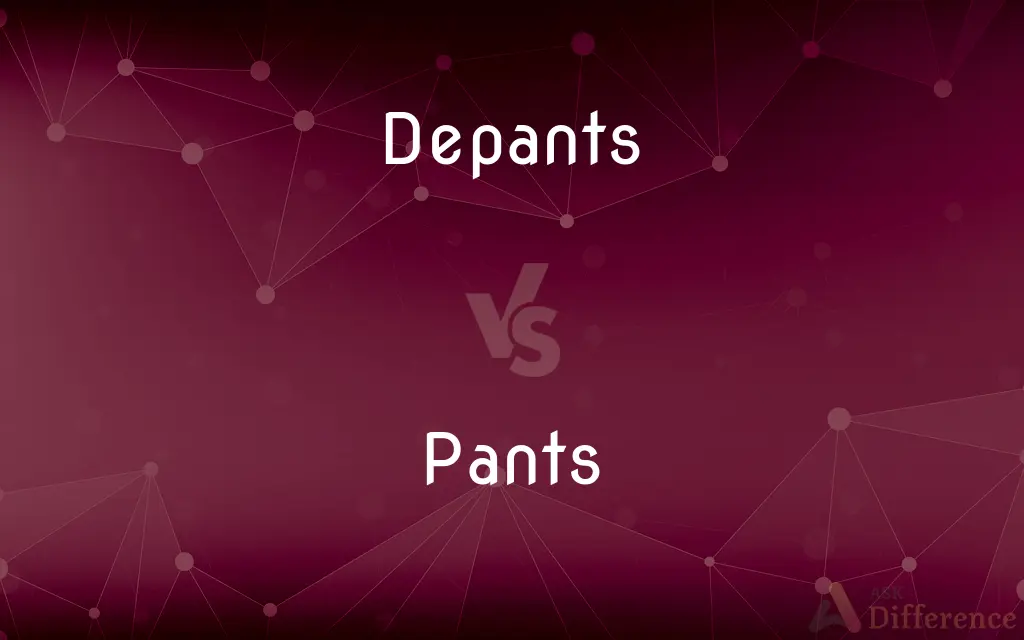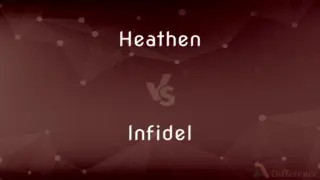Depants vs. Pants — What's the Difference?
Edited by Tayyaba Rehman — By Urooj Arif — Updated on March 20, 2024
Depants involves removing someone's trousers, often as a prank, while pants refers to wearing trousers or the act of pulling them up.

Difference Between Depants and Pants
Table of Contents
ADVERTISEMENT
Key Differences
Depantsing is the act of pulling down someone's pants as a form of prank or humiliation, typically leaving the underwear exposed and is considered an embarrassing and often inappropriate action. Pants, in contrast, not only refers to the garment itself, covering the body from the waist to the ankles with separate sections for each leg but also can mean the act of pulling up and securing one's trousers, ensuring they are worn properly and comfortably.
While depantsing is viewed negatively due to its intent to embarrass or humiliate, panting as an action (related to wearing or adjusting one's pants) is a neutral or positive activity associated with personal grooming and decency. Pants as a garment are essential in various cultures for everyday wear, professional settings, and formal occasions, reflecting a wide range of styles, materials, and purposes.
The term depantsing is specific to the act of removing pants and has no variations in terms of purpose or context—it is always associated with the act of pulling down someone's trousers or shorts without their consent. On the other hand, pants have diverse meanings and uses, including being a staple clothing item across the globe, representing different fashion statements, and serving functional purposes in different weather conditions and activities.
Cultural perceptions play a significant role in how both actions are viewed. Depantsing is often considered a juvenile or inappropriate act that invades personal space and dignity. In contrast, the significance of pants varies greatly across cultures, from being a basic necessity to a fashion statement, with the act of panting (adjusting one's pants) seen as a routine part of dressing.
Comparison Chart
Definition
Act of pulling down someone's pants as a prank
Garment covering the body from the waist to the ankles; also, the act of pulling up one's pants
ADVERTISEMENT
Context
Negative, often associated with humiliation
Neutral or positive, related to dressing or fashion
Cultural Perception
Viewed as inappropriate and invasive
Essential garment, varies from casual to formal wear
Variations
None, always involves removing pants
Wide range, including different styles, materials, and functions
Intent
To embarrass or humiliate
To dress, adjust clothing, or make a fashion statement
Compare with Definitions
Depants
Can lead to disciplinary actions in schools or workplaces.
He was suspended for attempting to depants another student during lunch.
Pants
Reflects a wide range of styles and materials.
Leather pants have become a popular fashion statement in recent years.
Depants
To forcibly pull down someone's pants as a form of humiliation.
The pranksters decided to depants their friend in the schoolyard, causing embarrassment.
Pants
Essential in various cultures for everyday wear.
In many professional settings, wearing pants is considered standard attire.
Depants
An act often considered bullying or harassment.
The school implemented strict rules against depantsing after several complaints.
Pants
A garment covering the body from the waist to the ankles, with separate sections for each leg.
She chose a pair of blue pants for her job interview.
Depants
Seen as an invasion of privacy.
Victims of depantsing often feel violated and seek to avoid the perpetrators.
Pants
To pull up and secure one's trousers properly.
After jumping into the lake, he had to pants quickly before returning to camp.
Depants
To remove the trousers from (someone), often by force or surprise as a prank.
Pants
Serves functional purposes in different weather conditions.
Waterproof pants are essential for hiking in rainy climates.
Pants
Underpants or knickers.
Pants
Trousers
Corduroy pants
Wide pant legs
Pants
Rubbish; nonsense
He thought we were going to be absolute pants
Pants
To breathe rapidly in short gasps, as after exertion.
Pants
To beat loudly or heavily; throb or pulsate.
Pants
To give off loud puffs, especially while moving.
Pants
To long demonstratively; yearn
Was panting for a chance to play.
Pants
To utter hurriedly or breathlessly
I panted my congratulations to the winner of the race.
Pants
A short labored breath; a gasp.
Pants
A throb; a pulsation.
Pants
A short loud puff, as of steam from an engine.
Pants
An outer garment that covers the body below the waist, usually to the ankles, and is divided into sections to fit each leg separately
She decided to wear pants instead of a skirt. He bought a new pair of pants.
Pants
Underpants.
Pants
An outer garment that covers the body from the waist downwards, covering each leg separately, usually as far as the ankles; trousers.
Pants
An undergarment that covers the genitals and often the buttocks and the neighbouring parts of the body; underpants.
Pants
Rubbish; something worthless.
You're talking pants!
The film was a load [or pile] of pants.
Pants
Of inferior quality, rubbish.
Your mobile is pants — why don’t you get one like mine?
Pants
A garment extending from the waist to the knee or ankle, covering each leg separately.
Pants
Underpants.
Pants
Underpants worn by women; panties.
Pants
(usually in the plural) a garment extending from the waist to the knee or ankle, covering each leg separately;
He had a sharp crease in his trousers
Pants
(usually in the plural) underpants worn by women;
She was afraid that her bloomers might have been showing
Common Curiosities
What are some reasons for depantsing being viewed negatively?
Depantsing is viewed negatively due to its intent to embarrass, its invasive nature, and the potential for it to be considered harassment or bullying.
Is depantsing considered bullying?
Yes, depantsing is often viewed as a form of bullying or harassment, especially in schools or public settings.
Are pants culturally universal?
While pants are a common garment in many cultures, the styles, materials, and the importance placed on them can vary greatly.
How have pants evolved in fashion?
Pants have evolved significantly, reflecting changes in fashion trends, cultural influences, and functional needs across different periods.
Can wearing certain styles of pants make a fashion statement?
Yes, the style, material, and design of pants can make a strong fashion statement and reflect individual tastes and trends.
Why is it important to wear pants properly?
Wearing pants properly is important for comfort, decency, and in many cases, compliance with social norms and workplace dress codes.
Can depantsing have long-term effects on victims?
Yes, victims of depantsing may experience long-term embarrassment, social anxiety, or distress, highlighting the seriousness of the act.
What does it mean to depants someone?
Depantsing someone means forcibly pulling down their pants, usually as a prank, leading to embarrassment and humiliation.
Can pants refer to both the garment and the action of wearing them?
Yes, "pants" can refer to the garment itself and the act of pulling up and securing trousers properly.
How can one prevent depantsing?
Awareness, anti-bullying education, and strict rules against such behaviors can help prevent depantsing incidents.
How do schools typically handle incidents of depantsing?
Schools often treat depantsing as a serious matter, potentially leading to disciplinary actions against the perpetrators due to its bullying nature.
What are some popular types of pants?
Popular types of pants include jeans, chinos, dress pants, leggings, and cargo pants, each serving different styles and functions.
What role do pants play in professional settings?
In professional settings, pants are often part of the required attire, signifying professionalism and adherence to dress codes.
Is there a gender preference for pants in fashion?
While historically there may have been gender preferences, modern fashion sees pants worn and styled by people of all genders.
Share Your Discovery

Previous Comparison
Grew vs. Growed
Next Comparison
Heathen vs. InfidelAuthor Spotlight
Written by
Urooj ArifUrooj is a skilled content writer at Ask Difference, known for her exceptional ability to simplify complex topics into engaging and informative content. With a passion for research and a flair for clear, concise writing, she consistently delivers articles that resonate with our diverse audience.
Edited by
Tayyaba RehmanTayyaba Rehman is a distinguished writer, currently serving as a primary contributor to askdifference.com. As a researcher in semantics and etymology, Tayyaba's passion for the complexity of languages and their distinctions has found a perfect home on the platform. Tayyaba delves into the intricacies of language, distinguishing between commonly confused words and phrases, thereby providing clarity for readers worldwide.














































